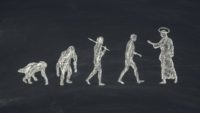By Brandon Clay How Disney has been slowly pushing the homosexual agenda for decades and two ways Christians can respond biblically …read more Source: AIG Daily
The Scottish island of Kerrera has produced the earliest known bug in the fossil record, a millipede.1 It was found in Silurian System rocks recently claimed by secular scientists to be 425 million years old.1 Unexplainably, their millipede fossil just seemed to show up, fully-formed as a completely functioning “creeping thing.” This discovery also caused some consternation with the uniformitarian … More… …read more Source: icr.org
About 3,000 years ago, the Bible taught that the “wonders in the deep” are the “works of the Lord.”1 Now that truth has been illustrated with even greater depth by the documented sighting of a super-deep-sea octopus—about 21,000 feet deep at the ocean’s bottom, to be specific.2,3 The deepest ever sighting of an octopus has been made by came… More… …read more Source: icr.org
By Simon Turpin Atheists discard evidence for God because of their naturalistic philosophy while accepting evidence for things far less probable. …read more Source: AIG Daily
The peppered moth myth takes on a new dimension. But genetic evidence shows no novel information caused the change between light and dark moths. …read more Source: creation.com
By Troy Lacey A skeptical social media post is making the claim that the lesser mole-rat (one of several blind mole rats) is evidence against intelligent design. …read more Source: AIG Daily
How can we find joy, peace, and hope during dark times? What’s going on in ICR’s virtual classroom? How does the Flood model solve the Antarctica rainforest mystery? Does Scripture say anything about climate? Discover the answers to these questions and more in the June 2020 issue of Acts & Facts! …read more Source: icr.org
The dwarf planet Ceres is generating wonder and consternation amongst scientists …read more Source: creation.com
A massive canyon rivalling Grand Canyon has been discovered beneath the ice on Greenland, and uniformitarian scientists are explaining it as a consequence of flooding.1 We couldn’t agree more. Greenland canyon is as deep as Grand Canyon and is about 450 miles long.2 It is too old to be a result of the Ice Age, so the mystery of how it could have formed has baffled uniformitarian geologists. … More… …read more Source: icr.org
By Ken Ham Just when you think you’ve heard and seen it all, mankind invents a new level of depravity. What am I talking about? Well, it’s a new reality show shown on the Fox broadcasting channel called Labor of Love. In this show, fifteen men will compete to be the one who gets to father a child with a woman who’s ready to start a family, but with no husband. Yes, you read that right. As one article described it, this show will “skip the dating and go straight to baby-making.” Love, apparently, is optional. No longer is sexuality—and [More]
One particular common cuckoo will soon complete a mammoth migration through both Africa and Asia—a migration that is anything but common. Onon is “one of five Cuckoos that were satellite tagged in Mongolia last summer.” He will soon complete a journey of about 7,500 miles from his winter home in Zambia (southern Africa) up to his breeding grounds in Mongolia. “The bird has survived ocean crossings and high w… More… …read more Source: icr.org
Delving into DNA’s mind-blowing, multi-layered information system …read more Source: creation.com
Death will come to all of us unless Christ returns, so how can we be comforted after the death of a loved one? Read More
One lone elm tree survived a deadly “elm disease.” Nicknamed “Ent Tree” (alluding to arboreal heroes in J. R. R. Tolkien’s The Lord of the Rings), this elm won Scotland’s “Tree of the Year” status in 2019.1,2 It was planted in 1919 as a memorial to WWI soldiers.1 However, it failed to place within 2020’s Top 10 of Europe’s “Tree of the … More… …read more Source: icr.org
By Ken Ham During this time that’s been so difficult for so many families in the US and elsewhere, we’ve been offering a variety of free or very discounted specials to help families and churches be equipped with answers, have their faith strengthened, and to boldly proclaim the gospel to others. These specials won’t be around forever so be sure to take advantage of them now to equip and encourage yourself and to share the truth with others. As we move towards our reopening of the Ark Encounter and the Creation Museum on June 8, many of these specials are [More]
A new study published in Earth and Planetary Science Letters has determined that P?h?honu volcano is the world’s largest by volume and the hottest.1 Found almost 700 miles northwest of Hawai’i, P?h?honu volcano is almost completely submerged beneath the Pacific Ocean.2 Only two small, rocky remnants stick up to about 170 feet above the surface, exposing only six acres in area.1 More… …read more Source: icr.org
By Roger Patterson Considering the history of plagues, pestilences, and earthquakes, should Christians think the end is near in light of the current COVID-19 crisis? …read more Source: AIG Daily
By Ken Ham We have an incredible fossil here at the Creation Museum that guests can see in one of our excellent exhibits. It’s a fossil of a fish halfway through swallowing another fish, which was supposed to be its dinner! This fossil clearly points to catastrophic burial—the fish didn’t even have time to finish swallowing its prey before it was rapidly buried. Well, a fossil discovered off the coast of England tells a similar story. A squid-like creature, called a belemnoid, with “ten arms covered with hooks,” was fossilized with a fish that had been viciously killed, presumably for [More]
God’s handiwork is not just apparent in the amazing complexity of individual creatures, but also in how they interact to form vital parts of entire ecosystems and even to keep life on this planet functioning as a whole. In light of this ecological paradigm, scientist have just revealed the previously hidden and indispensable role that moths play in the nighttime pollination of flowers.1 Pollinators are an important… More… …read more Source: icr.org
May and June are abuzz with busy bees, really clever bumblebees.1,2 And their practical cleverness continues to astonish researchers, as a recently published study in the journal Science illustrates.3,4 Bees have been delighting creationists for generations.1,5-7 These intelligent creatures can distinguish different humans from each other, as individuals, retaining memory of who is whom.More… …read more Source: icr.org
How could T. rex be buried with sharks in the same rock formation? Read More
Tens of thousands of volcano-looking features exist across the northern lowlands and other areas across Mars.1 In the past, these volcanoes were thought to be caused by lava flows from the planet’s interior. However, a new study published in the journal Nature Geoscience has postulated that many of these “volcanoes” may have actually flowed mud, not lava.1 Petr Brož from the Czech A… More… …read more Source: icr.org
By Ken Ham Did you know wedding pictures could be a “microaggression”? Well, apparently, they can be, at least according to two academics! As employees are increasingly working from home during COVID-19, online meeting apps, such as Zoom, are being used more frequently than before. Well, these two academics (one from Michigan State University and one from the University of Colorado, Denver) are worried that the use of these online meeting platforms is “a ripe setting for unconscious bias.” Why? Because someone, they say, might put their wedding photo—of a man and a woman—as their virtual background and “unintentionally reinforce [More]
Are women superior to men because they have one more X chromosome? Read More
A new study published in the journal Gondwana Research has identified a rather out-of-place bone from a theropod dinosaur called an elaphrosaur that apparently didn’t eat meat.1 In fact, it was toothless. Adding to the mystery, it was found in rocks thought by secular scientists to be 40 million years too young.2 Furthermore, the dinosaur was found in a location that is claimed to have been close to t… More… …read more Source: icr.org
By Ken Ham Has the coronavirus brought out the best or the worst in you? I want to share what I’ve observed concerning our supporters, staff, opponents, and others. …read more Source: AIG Daily
We are already contending with the COVID-19 virus and the recent spate of murder hornets in the Pacific Northwest, but now sobering news coming out of Georgia sounds like a B-level horror movie. According to the Georgia Department of Natural Resources, a large invasive lizard—hailing from Guiana to Uruguay in South America—has now been discovered in areas of south Florida and two Georgia counties. The squat-bodied ugly … More… …read more Source: icr.org









































